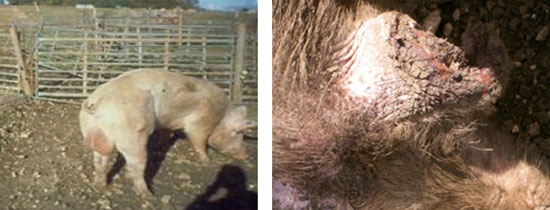In the young pig Streptococci and Staphylococcal infections of the mouth and chin are commonly associated with teeth clipping. Necrobacillosis is associated with poor hygiene Tail clipping in poor conditions will produce a whole variety of tail infections and there is a specific tail necrosis of unknown aetiology.
Scalding of the perineum may be related to the pH of the urine on abnormal diets such as citrus pulp.
Transit erythema may occur as a result of transport causing stress and it usually passes off after rest.
You might also say that there are a variety of conditions which occur to the skin because it is a limiting membrane surrounding the pig’s organs. These affect the skin by virtue of the fact that the skin encloses the pig and therefore limits the body shape. It can therefore be subjected to all sorts of trauma possibly with subsequent abscesses (including capped hock and elbow, knee erosions) sunburn, photosensitisation, insect bites, fleas, mosquito bites (watch out tiger mosquitoes are particularly bad), ear necrosis (spirochaetosis is specific, see Fig 6) caused by salmonellae or H. parasuis, bursitis, adventitious bursa formation and adventitious bursitis, mastitis shoulder ulcers, calluses.

| Figure 7. Typical outdoor trauma – boar with bruised back and hind leg | Figure 6. Necrotic ear (Spirochaetosis) |
A whole variety of lumps and bumps (see Fig. 7) may also be seen particularly those affecting the lymph nodes eg Aujesky’s disease and tuberculosis in the sub-mandibular glands, and PMWS in the superficial inguinal nodes. Hard lumps as a result of mastitis or nocardial/actinobacillus infections may be found in the mammary glands and mishapen granulomatous vulvas may be seen as a result of vulval biting in newly batched gilts.
Specifically, we have the following skin conditions
Swine pox- may occur as a congenital infection or in conjunction with Staphylococcus hyicus (Greasy Pig) infection and appears as brown crusty or blistered lesions. A skin scrape and histology or electron microscopy will soon differentiate.
Staphylococcus hyicus (Greasy-Pig Disease) may only affect the sides of the face but also the whole body with vast release of serum the skin becomes crusty. Diagnosis is by clinical signs as isolation of the Gram positive organisms from the skin.
Mange- big crusty lesions particularly the ears, causes economic loss, diagnosed by skin scraping but is easily treated (Avermectins) but needs to be regular and on a herd basis. a lot of the reaction is often caused by hypersensitivity reactions.
Ringworm usually Trichophyton mentagrophytes is seen as dirty marks on the skin. Skin scrape including roots of hairs will lead to diagnosis. Unlike mange which is extremely itchy this is often free from pruritus.
Lice- can see the louse eggs on the hairs, it is a sucking louse in the pig and can spread disease but is easily treated.
Pityriasis rosea, often called false ringworm is believed to be an autosomal recessive, it develops about 8 weeks of age and has gone by 20 weeks.
Parakeratosis, is a zinc-responsive skin condition associated with the feeding of rations containing less than 40mg of zinc/kg dry matter. There are cases when it occurs where rations are high in calcium or soya protein or if low in fatty acids. The skin is usually reddened at first and then the rash becomes papular, scaly, dry and crusty particularly over the lower limbs and ventral abdomen. Secondary infections may follow and also abscesses. Diagnosis is from the history and confirmation may be from the histological picture of parakeratotic hyperkeratosis.




